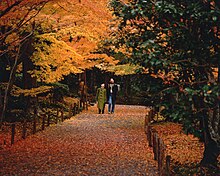Momijigari

A couple under maple trees in Ryōan-ji near Kyoto
Momijigari ( Japanese. 紅葉 狩 り ) from Japanese momiji ( 紅葉 , dt. "Red leaves" or "autumn leaves") and kari ( 狩 J "hunt") denote the Japanese custom of autumn landscapes and parks with beautiful autumn leaves, especially maple trees and forests to visit.
It is also referred to as kanpūkai ( 観 楓 会 ) in Hokkaidō . Like Hanami, the custom is an achievement of the Heian period and led to the creation of appropriate parks in the vicinity of Kyōto and Nikkō . When Indian Summer in North America and the Indian summer in Central Europe, however, the associated natural spectacle is emphasized.
Momijigari (autumn hunt) also refers to the Kabuki adaptation of the older Nō drama by Kanze Kojirō (1435-1516), which was premiered in 1887.
Individual evidence
- ↑ Sapporo Year Round: Attractions and Events in Four Seasons ( Memento of the original from August 20, 2012 in the web archive archive.today ) Info: The archive link was automatically inserted and not yet checked. Please check the original and archive link according to the instructions and then remove this notice. Sightseeing around Sapporo
- ^ Samuel L. Leiter, New Kabuki Encyclopedia. A Revised Adapation of Kabuki Jiten . Westport and London, 1997, p. 416 (English)
Web links
- Momijigari , Japanese annual calendar